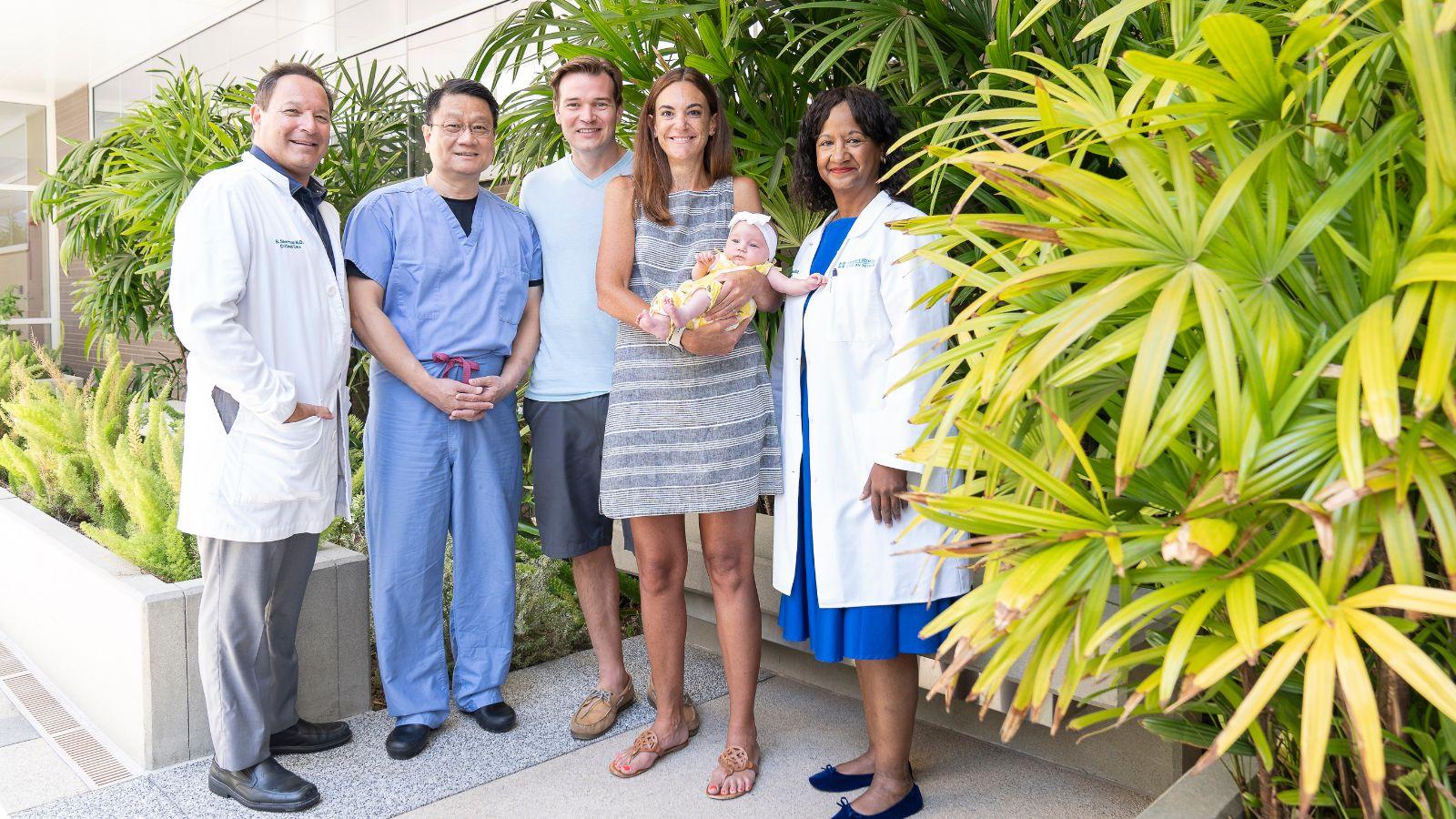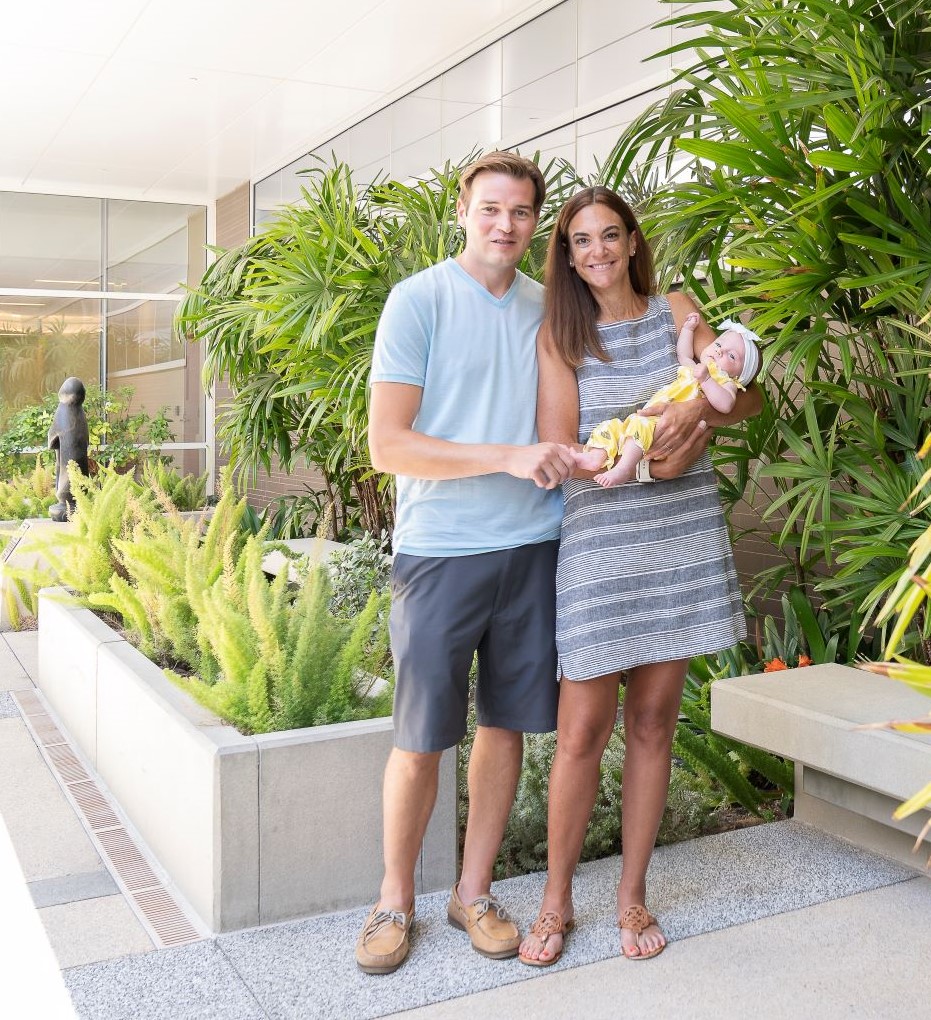
(Above) Britney Mula's medical teal (from left): Brian Sherman, MD George So, MD fiance Timothy Webb, Britney, baby Savannah and Cheryl Sanders, MD
Written by John Ferrari | Photographed by Vincent Rios
Pregnancy can be an emotional time, and that’s normal. Scary isn’t normal, but sometimes pregnancy can be scary. Scary is what happened to Britney Mula and her fiancé, Timothy Webb, as they awaited the arrival of their baby girl, Savannah. Thanks to quick thinking and a high-tech intervention, this scary situation has a happy ending.
As Britney recalls, the first 35 weeks of her pregnancy “were super easy—it was great.” But in early April, five weeks away from a full-term pregnancy, her left leg felt sore. She had exercised that day and chalked it up to a good workout.
Over the next three days, however, the pain became steadily worse, and Britney went to see her OB-GYN, Cheryl Sanders, MD, of Torrance Memorial Physician Network. In less than five minutes, an ultrasound revealed an extensive blood clot.
Dr. Sanders called in Torrance Memorial’s interventional radiology (IR) team, and Britney was diagnosed with deep vein thrombosis (DVT). That’s a serious condition for anyone, but especially for Britney, says interventional radiologist George So, MD.
First, the blockage was large, extending from Britney’s calf to below her abdomen. Second, there’s always the potential for a blood clot to dislodge and travel to the lung’s pulmonary artery, becoming a pulmonary embolism. The pressures associated with childbirth increase the potential for this life-threatening condition. At the same time, placing Britney on anticoagulants to manage the blockage and pain medication to manage her symptoms was potentially dangerous for a pregnant woman.

Although a pregnancy of 39 to 40 weeks is ideal, Dr. Sanders says delivery at 37 weeks is considered early full-term. Could Britney’s delivery be delayed for at least two weeks, even with a serious embolism?
With Britney’s agreement, Dr. Sanders and Dr. So decided to admit her to the labor and delivery department for two weeks while administering medication for the DVT. At 37 weeks, they would induce labor and, immediately following delivery, operate to remove the clot. Correctly timing when to stop and restart the medications would be crucial.
At 37 weeks, after an induced labor was unsuccessful, Savannah was safely delivered via C-section. Just hours later, Britney was wheeled into Torrance Memorial’s IR suite to remove the 30-inch blood clot using minimally invasive surgery made possible by the Inari ClotTriever—a specialized device designed specifically to remove DVT embolisms.
The device and the Inari FlowTriever, designed to remove pulmonary embolisms, are at the leading edge of treatment for blood clots, Dr. So says. “Most hospitals do not have an interventional radiologist, and only a small number of hospitals have these Inari devices. With them, thrombectomies can be performed as outpatient surgeries without the need for the patient to stay in the ICU. The procedure is very quick, and there’s much lower risk.”
In Britney’s case, “The plan worked out beautifully,” he says. Her pain disappeared as soon as the procedure was complete. “Honestly it was a really easy procedure,” Britney recalls.
The Inari ClotTriever and FlowTriever are game changers in the treatment of blood clots, says Brian Sherman, MD, a Torrance Memorial medical/surgical intensivist and chair of the critical care department. Treated with these devices, patients “immediately feel better on the table, and you’ve instantaneously saved their lives,” he explains.
The devices are part of Torrance Memorial’s campaign to better serve the South Bay by being a regional center of excellence for cardiogenic shock and pulmonary embolism, a multidisciplinary program including IR, pulmonary and cardiac critical care, and the emergency room.
“The program allows us to diagnose patients with cardiac shock or large pulmonary embolisms causing shock and direct them to immediate lifesaving procedures,” Dr. Sherman says. “We have an array of tools here, from anticoagulant medicines to catheter-directed thrombolysis and the Inari device, assisted if needed by the Impella device and the ECMO (extracorporeal membrane oxygenation) support system. So for patients like Britney, we can remove clots without anticoagulation or the risk of bleeding from clot-busting drugs.”
Beyond the latest technology though, what Torrance Memorial patients see is the compassionate care they’re getting from dedicated physicians, nurses and specialty support teams. “The team is absolutely amazing,” Britney says. “I don’t think I could’ve gotten better care anywhere in the world.” •






